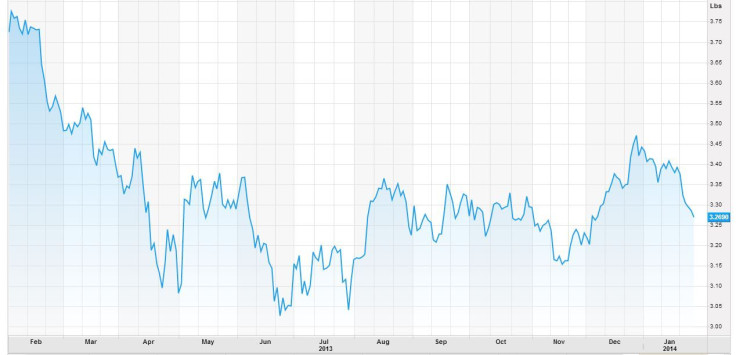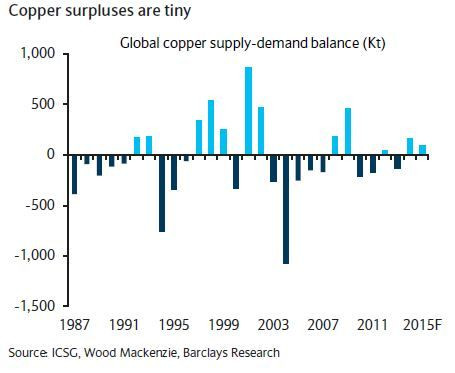Copper Prices May Be On The Rise, In Sharp Contrast To The Other Much Duller Commodities Markets
Analysis

Commodities have started to seriously bore Wall Street. That's because commodity prices are expected to hold steady -- at best -- this year and many are expected to fall. Production is generally seen as keeping pace with or exceeding demand and inventories of a number of commodities are not low enough to bolster prices.
Barclays PLC put it succinctly recently in noting that commodity returns will remain “sluggish for some time to come.”
Consider oil, the most heavily traded commodity. The U.S. shale revolution is pushing the nation closer and closer to being able to export rather than import crude oil. Tensions between Iran and the West appear to be easing, and there are tentative signs of improving crude oil production from western Libya, particularly its massive El Sharara field, which has a production capacity of some 350,000 barrels per day. Oil prices are widely believed to have nowhere to go but down.
Even the risk of supply disruptions from South Sudan or continued output problems in eastern Libya are not expected to boost global oil prices, according to Goldman Sachs analyst Jeffrey Currie, writing in a note that “oil price risks are substantially skewed to the downside in 2014.”
Other commodity prices appear headed south. Ethanol prices are already trending lower in response to the U.S. government’s decision to not increase the amount of the commodity that gasoline refiners must blend. And since fuel production monopolizes as much as 40 percent of the U.S. corn crop, that is weighing on the corn prices.
Capital Economics commodities economist Tom Pugh wrote recently that he forecasts corn to fall to $3.50 per bushel this year from $4.20 per bushel in December.
“We expect demand for grains, especially corn, to be subdued over the next year,” he wrote in a note.
Strong supply will weigh on other commodity prices. This season’s wheat harvest is projected to climb to a record, according to the U.N.’s Food and Agriculture Organization. Barley prices are expected to be capped by high stockpiles and competition with other grains and oilseeds. International soy bean prices have fallen from the peaks of the drought-reduced output in the 2011-12 season, IGC said. The global cotton market, meanwhile, is bracing for a massive influx of supply from China’s huge stockpile, which it now no longer wants to maintain. The upshot of all these forecasts is a broad-based pessimism among Wall Street investors about what comes out of the ground.
But amid all this gloom, one commodity could begin to sparkle: copper. Over the last 12 months the price of the red metal has fallen more than 12 percent, from $3.72 per pound to $3.26 per pound.

But there are fundamental changes afoot that should raise it out of its doldrums. In fact those changes have already begun emerging: from Dec. 11, 2013, to Jan. 8, 2014, copper’s price edged up 1.7 percent.
It's hard to overstate the importance of copper prices, both to numerous industries as well as the global economy. In the U.S., demand for products made of copper, 60 percent of which is used to make wire, comes primarily from four sectors. One is construction. That includes home builders like Hovnanian Enterprises Inc. (NYSE:HOVU), D.R. Horton, Inc. (NYSE:DHI) and Lennar Corporation (NYSE:LEN), which buy wiring, plumbing and appliances that contain the metal. The construction sector also includes industrial builders like closely-held Bechtel Group, Inc., KBR, Inc. (NYSE:KBR) and Fluor Corporation (NYSE:FLR) that assemble power plants, drilling platforms and factories. A second source of copper demand comes from utilities and companies that own and operate the vast transcontinental high-power lines that crisscross the nation and constitute the bulk power grid. Both builders and utilities buy their products from companies like Germany's ThyssenKrupp AG, which turns copper into wire, tubes, sheaths, plates and coils. A third source of copper demand is manufacturers of electronic products like smart phones such as Apple Inc. (Nasdaq:AAPL) and Samsung Electronics Co., Ltd. A fourth industry that buys large amounts of copper products is the car and truck industry. The average automobile, for example, contains nearly one mile of copper wiring, while the total weight of copper in cars ranges from 50 pounds for compacts to as much as 100 pounds for luxury and hybrid cars.
There are three reasons that copper prices may rise this year.
Chinese demand
The State Grid Corporation of China (SGCC), which provides power to 80 percent of the world’s second-largest economy aims to boost by 13 percent its annual investment to more than $60 billion, according to research by Barclays PLC.
Given that Chinese utilities account for more than 40 percent of Chinese copper demand, that sort of big jump in capital investment should firm up prices.
“We had forecasted a gradual normalization of spending throughout 2013, as the year started with investment up 44 percent, year-over-year,” Barclays analyst Sijin Cheng wrote in a note. “Grid investment growth softened as expected (last year). However, the new (SGCC) target exceeds our expectations and suggests that copper demand from the power sector could stay as strong, if not stronger, in 2014.”
Prospects of significantly stronger Chinese copper demand this year contributed to Citigroup Inc (NYSE:C) raising its stance on the mining sector, including copper mining, to Bullish from Neutral. “While we remain concerned about the potential long-term structural demand story for commodities in China, and we are cognizant of a potential seasonal slowdown in the first quarter of this year, our move to bullish reflects better bottom-up fundamentals, particularly from the major miners. We would rather be too early than too late in making this call.”
China is not the only source of expected rising copper demand.
In its “Global Outlook,” Barclays said worldwide demand for the red metal rose throughout 2013. By yearend the investment bank said its estimate of “2013 global copper demand is almost 50 percent higher than the low point for our forecasts reached in Q2 and is almost three times the average growth rate of the 2000s.
“For 2014 we forecast demand growth to be a little slower, but if our forecast of around 800,000 tons is achieved, then demand growth in 2013-14 will be the third strongest two-year demand growth expansion in the copper market for more than 20 years.”
If European economic growth continues advancing this year, the continent will also account for increased copper demand.
Supply growth
Strikes, storms and scheduled maintenance of major copper processing facilities are flattening the growth in copper production. Barclays said in a Jan. 13 note that the rate at which global copper supplies are growing will peak this year and then begin to slow next year.
Chile -- Output at Codelco’s 300,000 ton per year Chuquicamata smelter was halted for most of December due to a strike.
Philippines -- Glencore’s Pasar smelter in the Philippines remains closed since Typhoon Haiyan slammed into the country on Nov. 7, 2013.
Australia -- BHP Billiton plans a maintenance outage at its Olympic Dam smelter in March.
Indonesia -- Freeport-McMoRan has suspended copper concentrate exports from its huge Grasberg mine in Papua as it fights a sudden 25 percent export duty that will grow to 60 percent by 2016 on copper concentrate exports. That led Deutsche Bank to cut its 2014 copper sales estimates by 120 million pounds, assuming a full first-quarter of export disruptions.
China -- Barclays said Jan. 24 that its final estimate of the nation’s refined copper production of 6.5 million tons was lower than the reported total of 6.9 million tons.
Global inventory
In addition to higher demand and production constraints, the global stocks of already-mined copper are tightening. A year ago, according to Barclays, copper stocks were about 1.46 million tons. That rose to 1.81 million tons in April of last year and has been falling ever since. On Dec. 13 global copper stocks had declined to an estimated 1.27 million tons. Further, the metal’s on-warrant inventory has shrunk to its lowest level since 2008.

UBS AG raised its near-term copper price forecast on China’s “robust commodity trade and due to Brazil’s weak supply growth.” Specifically, UBS increased by 6 percent an earlier 2014 copper price forecast of $2.95 per pound, although the investment bank still sees copper prices this year lower than last year. UBS also raised its copper price forecasts for 2015 slightly to $2.90 from $2.85.
--
(Note: Copper wire photo by Shutterstock.com.)
© Copyright IBTimes 2024. All rights reserved.
Join the Discussion






















